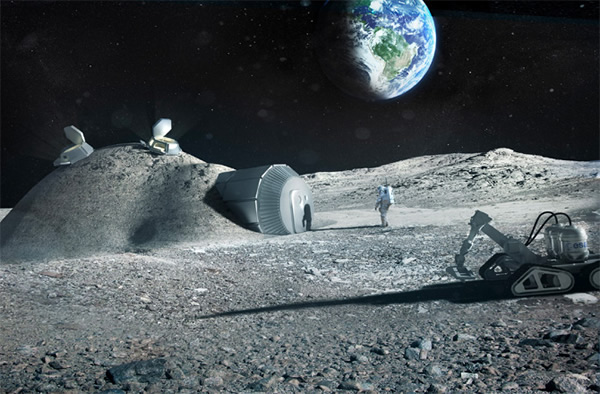Print Me a Condo on the Moon!
Print Me a Condo on the Moon!
There have been many plans — some good, some bad, some silly — to build the first manned base on the moon, but many have two key drawbacks: cost and weight. To launch any habitat from Earth to the moon (and, indeed, land it safely on the lunar surface) is costly, therefore novel ideas for habitat construction are needed. Wouldn’t it be great if we could build a lunar base from material mined in-situ (i.e., moon rock and regolith)?
One emerging technology that space engineers are currently eying is the 3D printer. Already being used in industry and the arts, 3D printers work by spraying a material — commonly some kind of plastic — layer by layer, often building complex shapes that wouldn’t normally be possibly via traditional construction techniques. The only restriction to the size of the object you’re printing is the size of the printer.
So the European Space Agency has revealed big plans for the technology after announcing a partnership with the renowned architecture firm Foster + Partners to assess the feasibility of using lunar material in an extraterrestrial 3D printer to build a moon base.
“Terrestrial 3D printing technology has produced entire structures,” said Laurent Pambaguian, ESA project lead, in a press release. “Our industrial team investigated if it could similarly be employed to build a lunar habitat.”
The architects have focused on a weight-bearing “catenary” dome design using a cellular wall to help shield future moon astronauts from micrometeorites and provide some protection against space radiation — two of the prime dangers of living and working on the lunar surface. An inflatable pressurized environment within the dome’s shell will also be incorporated into the design.
Using a 6-meter D-shaped demonstration printer, the UK-based company Monolite has created structures using a sand-like material held together with a binding salt which forms a stone-like solid.
“First, we needed to mix the simulated lunar material with magnesium oxide. This turns it into ‘paper’ we can print with,” said Monolite founder Enrico Dini. “Then for our structural ‘ink’ we apply a binding salt which converts material to a stone-like solid.
“Our current printer builds at a rate of around 2 m per hour, while our next-generation design should attain 3.5 m per hour, completing an entire building in a week.”
This technology has been singled out by space enthusiasts and engineers for some time. The Mars Foundation for example, a non-profit group focused on using in-situ resources to build a Mars base, has been researching this possibility for a potential Martian habitat. But it’s only recently that the technology has matured to a point where it’s conceivable that it could be used in space exploration.
“3D printing offers a potential means of facilitating lunar settlement with reduced logistics from Earth,” said Scott Hovland of ESA’s human spaceflight team. “The new possibilities this work opens up can then be considered by international space agencies as part of the current development of a common exploration strategy.”
But this isn’t the only strategy that will reduce costs when setting up home on the moon — other settlement contenders include inflatable digs or hunkering down inside natural geological features like lunar lava tubes.
So, lunar condos might be possible after all — but let’s just hope the “ink” doesn’t cost more than the printer and that paper jams are a rare annoyance.
Feb 1, 2013 03:34 PM ET by Ian O'Neill












